Madagascar
The French invaded Madagascar in 1895 and set up a colonial administration. Queen Ranavalona III was sent into exile in Algeria in 1897, effectively ending the monarchy. Foreign settlers and companies appropriated land for coffee plantations and established an agricultural based economy. The French held Madagascar continuously, except for a brief period of British occupation during WW II. A major revolt was crushed in 1947 at the cost of many thousands of Malagasy lives (possibly as many as 80,000).
Madagascar underwent a peaceful transition to independence in 1960. Philibert Tsiranana, the first president, gradually became more oppressive. He crushed a revolt in the country's south in 1972. . He resigned soon after and handed power to army commander, General Gabriel Ramantsoa.
By the late 1970s Madagascar had severed all ties with France and the government was seriously courting communist nations. Ratsiraka won re-election in March 1989 under dubious circumstances, which led to riots. The early 90s was plagued by civil unrest. After a four-year rule by Professor Albert Zafy that failed to unite the country, Ratsiraka was voted back into power in 1996. Growing opposition to Ratsiraka led to the popularity of Marc Ravalomanana, the mayor of Antananarivo. Presidential elections in December 2001 were inconclusive, with both Ratsiraka and Ravalomanana claiming victory. Ravalomanana declared himself president in February 2002 and set up shop in the capital of Antananarivo. Ravalomanana soundly defeated the fragmented opposition in elections in December 2002, thus securing the legitamacy of his government
Royal Era - Prior to 1894
Order of Ranavanola III (1861-1897)
Modeled on the Legion of Honor, the Order of Ranavanola III (also referred to as the Royal Order of Madagascar) was awarded in five classes (Grand Cross, Grand Officer, Commander, Officer and Knight). This Order, also known as the Order of the King Ranavanola, was awarded for exceptional service to the country.
The insignia is comprised of a gold star with seven rays, each ending in three points. Its design is very similar to the Royal Order of Cambodia. The central medallion is composed of three-quarters white and one quarter red enamel. The initials RM (Ranavanola Manjaka) are superimposed on the white enamel. The planchet is suspended from a gold and red enamel European style crown with the golden plumes of the king. The white and red ribbon reflects the angular design of the central insignia of the planchet.
Order or Cross of Merit (1861-1863)
Radama II instituted this Order, which existed in addition to the Royal Order. The design is a double-sided, seven-pointed, white enamel star with gold rays between each arm. It is suspended from a European style crown. The center bears the bust of Radama in profile on blue enamel surrounded by the inscription RADAMA II MANJAKA. The reverse has a palm tree in the center surrounded by the inscription MADAGASCAR. The ribbon is white with two light blue side stripes.
Other Notable Royal Medals:
- Cross of Radama II
- Medal of Radama II
- Plaque of Radam II
- Plaques of Rakotondradama
- Plaques of Ramboasalama
- Order of Ranavalona III (version 1)
- Order of Ranavalona III (version 2)
- Silver Plaques of Honor
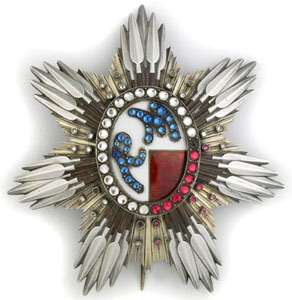
Order of Ranavalona Grand Cross Plaque
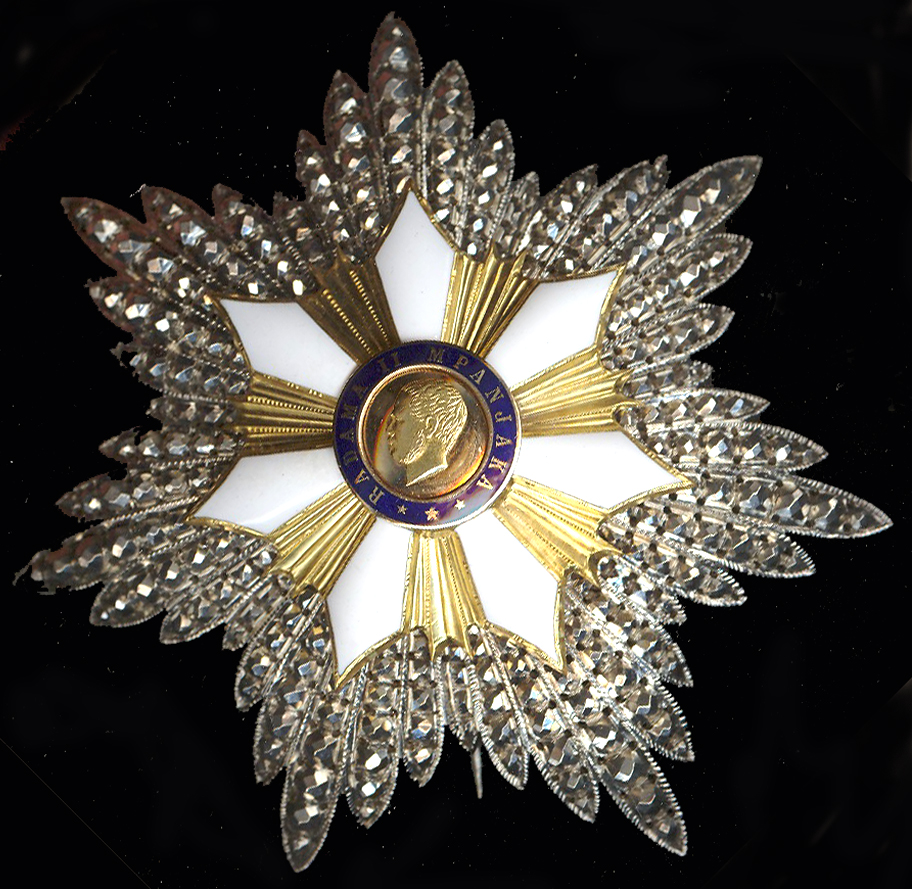
Order of Merit of Radama Plaque
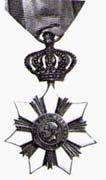



Order of Merit of Radama II (1st and 2nd version),
Order of Ranavalona III (3rd version)
& Medal of Radama II (Courtesy Emmanuel Halleux)
French Colonial Period 1894-1960




Commemorative Medals of the 1885 and 1895 Madagascar Expeditions,
French Colonial Medal of Merit (silver) and Medal of Honor for Labor (bronze)

The Colonial Medal with Madagascar
related bars
(Courtesy Hendrik Meersschaert)
The NOSSI-BE bar was issued to the French soldiers, who put down the Sakalave Revolt in 1849. The MADAGASCAR bar was issued to those who participated in the 1883-1886 and 1894-1895 Expeditions and again to those who helped quell the 1949 Revolt.
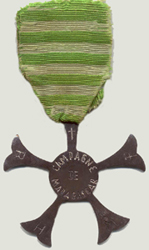
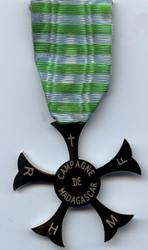
Variations of the Hand Engraved Madagascar Campaign Cross
Other French Colonial Medals:
- Medal of Honor of Posts and Telegraphs